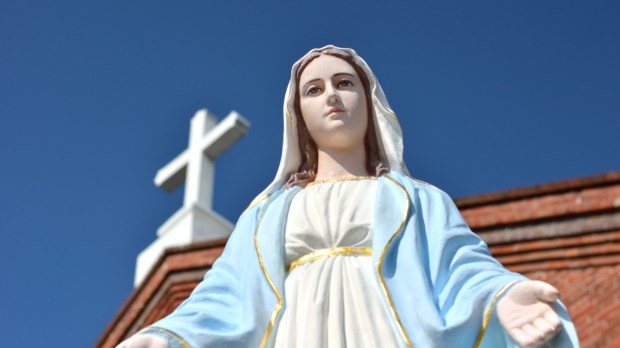Lourdes-en-Bigorre, March 3, 1858: On the banks of the river Gave, in the damp and dark cave of Massabielle, a woman appeared for the 14th time in about 20 days to a local girl named Bernadette. Pushed by her priest who wanted to know the identity of this “Beautiful Lady” the young Bigourdane questioned her. For an answer, she received a smile, and this smile was the Lady’s first answer to the teenager who wanted to know her name.
Before presenting herself, on March 25, as “the Immaculate Conception,” she gave her smile to be contemplated as the most appropriate doorway to her mystery. What does the Virgin Mary’s smile tell us about her mystery? How does it illuminate Advent, a time of vigilance and confident waiting for the Savior? How is it a sign of hope?
The Virgin Mary, certain that God’s love will be victorious
As Benedict XVI meditated in Lourdes on September 15, 2008, during the Mass for the Sick, “The Virgin Mary is today in the joy and glory of the Resurrection. Her tears at the foot of the Cross have been transformed into a smile that nothing will erase, and her maternal compassion for us remains intact.” This smile is thus a sign that in the midst of the greatest pain—her son dying on the Cross—that in the midst of the greatest injustice—the innocent Son of God is condemned by men—the Virgin Mary remains certain of the victory of God’s love over sin and death.
And Mary lived this victory of grace beginning from her own conception. Daughter of St. Anne and St. Joachim, Mary was conceived immaculate, that is, preserved from original sin, in anticipation of the benefits of Christ’s death and resurrection. “In her shines forth the eternal goodness of the Creator who, in his plan of salvation, chose her to be the Mother of his only Son” (Benedict XVI, Rome, December 8, 2005).
We are all called to be holy and immaculate
The biblical foundation of this dogma is found in the words that the angel addressed to the young girl of Nazareth: “Hail, you who are filled with grace! The Lord is with you” (Luke 1:28). “Full of grace” is the most beautiful name of Mary, the name God himself gave her, to indicate that she has always and forever been the beloved, the chosen one, the one chosen to receive the most precious gift, Jesus, “the incarnate love of God” (Deus caritas est, no. 12)” (Benedict XVI, Rome, December 8, 2006). Mary is the perfect receptacle to be filled with grace.
And if “the Cross is the place where God’s compassion for our world is perfectly manifested,” Benedict XVI said in Lourdes in 2008, “Mary shares the compassion of her Son. Because she lives and thinks with God, her heart is enlarged. In her, God’s goodness has come very close and is very close to us” (Benedict XVI, Rome, December 8, 2005).
In fact, this immaculate conception, which distinguishes Mary from our common condition, does not distance her from us but, on the contrary, brings her closer to us. “While sin divides and distances us from one another, Mary’s purity makes her infinitely close to our hearts, attentive to each one of us and desirous of our true good. …] What many, out of embarrassment or modesty, do not dare to entrust even to those closest to them, they entrust to her who is the most pure, to her immaculate heart: with simplicity, unblemished, in truth,” explained Benedict XVI when he returned to Lourdes in 2008.
Her immaculate design reflects on us
This mystery of the Immaculate Conception is not only for us to contemplate, but also to live it — as long as we believe in it and love it. This mystery is for us. “The grace of the Immaculate Conception given to Mary is not only a personal grace, it is for everyone. It is a grace given to the entire People of God,” Benedict XVI said in 2008. “First of all, because as sons and daughters of Mary, we benefit from all the graces given to her, and the incomparable dignity that her immaculate conception gives her reflects on us, her children,” he said. He added: “Mary loves each of her children […]; she loves us simply because we are her children, according to the will of Christ on the Cross. In Mary, the Church can already contemplate what she is called to become. Every believer can already contemplate the perfect fulfillment of his or her own vocation.”
And our vocation is to live by the mercy of God who frees us from sin. In Mary, this was accomplished from the moment of her conception, gratuitously and instantaneously. For us, although we were immersed in God at our baptism and washed of original sin, we still suffer the consequences. Therefore, our sanctification is accomplished gradually. It takes time for Christian grace to fully take hold within us. However, even if this will only be fully realized in Heaven, where we will be immaculate, it must nevertheless be realized on earth, starting today. “In the Mother of Christ and our Mother the vocation of every human being is perfectly realized,” the Apostle Paul reminds us, “all men are called to be holy and immaculate in the presence of God in love (Eph 1:4),” Benedict XVI, Rome, December 8, 2005.
A magnificent sign of hope
Mary’s immaculate conception is therefore a magnificent sign of hope for us. For hope means being certain that in Christ we are already victorious over sin and death. If we want it, God’s grace will fill everything. We do not hope for something that is to come, we hope for what is already present but veiled, a beatitude that is already present in us. And the Immaculate is given to us for this: “Vita, dulcedo, et spes nostra …” [Our life, our sweetness, our hope], as the Salve Regina goes.
“By presenting herself to Bernadette as the Immaculate Conception, the Blessed Virgin Mary came to remind the modern world, which was in danger of forgetting her, of the primacy of divine grace, stronger than sin and death,” Benedict XVI, Rome, February 11, 2006. “In the presence of Mary, by virtue of her purity, we are not afraid to show our weakness, to ask questions and express our doubts, to formulate our hopes and our most secret desires. The motherly love of the Virgin Mary disarms all pride; it makes us capable of looking at ourselves as we are and inspires in us the desire to convert in order to give glory to God,” said Benedict XVI in Lourdes in 2008.
The quest for Mary’s smile
“Mary dwells before God and also before all humanity as the immutable and intangible sign of God’s election of which the Pauline Letter speaks: in Christ, ‘he chose us in him before the foundation of the world, that we should be holy and without blemish before him in love: having foreordained us unto adoption as sons through Jesus Christ’ (Eph 1:4-5). There is more power in this election than in all the experience of evil and sin, than in all the ‘hostility’ that has marked the history of man. In this history, Mary remains a sign of assured hope” (John Paul II, Redemptoris Mater, no. 11).
In this time of Advent, and even afterwards, let us seek out Mary’s smile, the source of invincible hope. “In this simple manifestation of tenderness that is a smile, we understand that our only richness is the love that God has for us and which passes through the heart of the one who has become our Mother,” said Benedict XVI in Lourdes. His desire is that, by becoming attached to her, we allow ourselves to be led to the only source of salvation, her Son, Jesus.
Marie-Christine Lafon

Read more:
8 Ways to honor the Immaculate Conception this December

